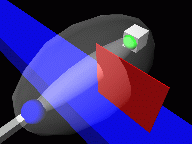

Compressed Postscript
file (A4 format, packed with gzip, 258 Kb)
| Citation
info
|
@inproceedings{TG97,
title = "Soundtracks For Computer Animation : Sound Rendering in Dynamic Environments With Occlusions", author = "Nicolas Tsingos and Jean-Dominique Gascuel", booktitle = "Graphics Interface'97, Kelowna B.C., Canada", year = "1997", month = "May", pages = "9-16" } |